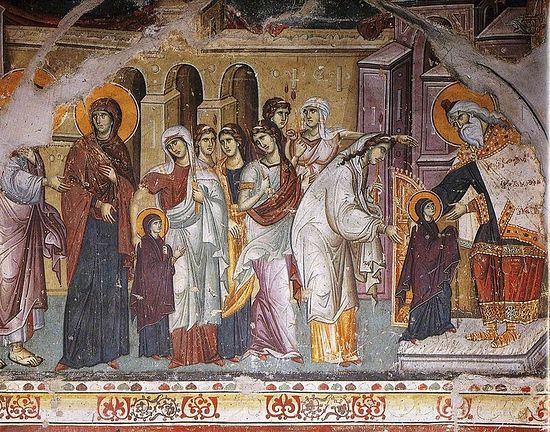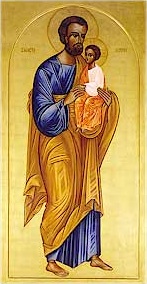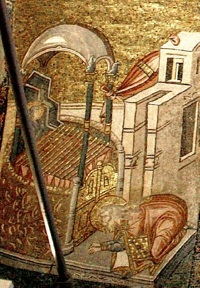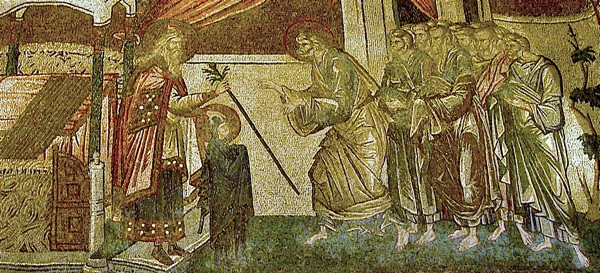 Entry of the Virgin Mary the Theotokos into the Temple. Panselinos, XIII century. Carey, Mount Athos
Entry of the Virgin Mary the Theotokos into the Temple. Panselinos, XIII century. Carey, Mount Athos
The Presentation of Mary
Righteous Joachim and Anna had been granted their wish for a child with a vow to dedicate their child to the service of God. As soon as Mary was weaned from milk they felt an urgency to fulfill the vow they had made to God. When she was two years old her father said, “Let us take her up to the temple of the Lord, that we may pay the vow that we have vowed, lest the Lord depart from us, or perchance, the Lord send us someone to warn us that we have been too long in paying our vow because our offering hath not been received.” But her mother replied, “Let us wait until her third year, so that our daughter might not be at a loss to know her father and also that she might not look for us.” So, they decided to wait another year.
Then at the third year they decided to present Mary to the temple. Her father, Joachim, said, “Let us invite the daughters of the Hebrews that are virgins. Let each maiden take a lamp and stand with the lamps burning, that the child might not turn back and then her mind would be set against the temple of the Lord.”
Her parents then departed for the temple with an escort of young maidens. When they arrived they dressed Mary with clean and elegant clothes. As they entered the temple there were fifteen steps that led from the court of the women to that of the men where the entrance to the sacred place was. The fifteen represented to the Jews the fifteen Psalms of Degree [Ps 119-133, LXX] where degree means ascent and were sung by jews as they made their pilgrimage to the temple. The temple was built on a mountain so many steps were required to reach the altar. Mary managed these steps without any difficulty and the whole company ascended into the temple. She relied on God’s help showing how we too should make our own effort and rely on God”s help to take the steps necessary for our entry into heaven.
The head priest at the temple at that time was Zacharias, the husband of the niece of Mary’s mother Anna, Elizabeth. He is the future father of Saint John the Baptist. The Priest then asks her to “enter into the Holy of Holies, for thou are much purer than myself. I, O Mistress, once a year enter therein, but you, can sit and abide forever. For you are the temple of God, therefore, remain in the temple. You are the vessel of the Holy Spirit, enter into the elect place. Wait there until you are vouchsafed to be the worthy vessel of the All-Holy Spirit. Rejoice and dance, for angels desire to minister unto you.”
Anna offered Mary to the priest saying, “Receive our daughter, O high priest or, much rather, god. Accept her who is pure and blameless and higher than heaven. Take her into the temple for that is where she,, the temple of God, must be and dwell. She is holy, and in a pure place she is to abide. Therefore I surrender her into the hands of God.
Zacharias, after hearing these words from Anna received Mary and kissed her. He said, “The Lord has magnified your name in all generations. In you, in the latter days, will the Lord make manifest His redemption of the Children of Israel. He sat her on the third step of the altar. Immediately God sent grace on her and she danced. Everyone loved her. She then wen up all the steps climbing maturely and speaking perfectly.
Joachim and Anna then left Mary with other maidens who lived in the apartments of the temple for rearing. They both marveled and praised God because mary did not look back. They returned to their home. For seven years Anna and Joachim visited Mary often until they reposed. Mary was became an orphan at the age of ten. Mary grew up in the temple until she was betrothed to Joseph.
Note: This event is not recounted in the New Testament, but is found in the Protoevangelion of James, an apocryphal book which was very popular in the early centuries of the Church.
Growing up in the Temple
Mary was in constant prayer while she was in the temple.
From morning until 9:00am she remained in prayer. From 9 -
3:00pm she was occupied with weaving that she had learned
to do. From 3:00pm she again applied herself to prayer.
She would receive food from an angel about 3:00pm.
Receiving mystical food from the angels she was brought to
maturity and made purer than the angels having heavenly
spirits as servants. She also received food from the
priests but his was distributed to the poor. she would
converse daily with the angels. Through this time she was
perfected to do the work of God. From the very beginning
of her life she was chosen among the chosen. She
exemplifies the importance of interior life of prayer in
our spiritual growth. As it is recorded in the Gospel of
Luke:
My soul magnifies the Lord and my Spirit rejoices in
God my Savior, for he has regarded the low estate of his
handmaiden. For behold, hence-forth all generations shall
call me blessed; for he who is mighty has done great
things for me and holy is his name. And his mercy is on
those who fear him from generation to
generation.(Luke 1:47-50)
When Mary was thirteen years of age it was no longer the custom for a woman to reside in the temple. When women reached puberty and began menstruating, they had to depart from the temple in order not to defile it because menstruation was considered unclean. It was now the time a young woman was to be married. Often young ladies were brought to the temple to live being dedicated to God. They received education in the doctrines, commandments and sacred rites. At this age of maturity they were instructed by the priest to leave and to find husbands. All the virgins did so except for Mary who vowed her virginity. she said, “It cannot be that I should know a man or that a man should know me.” She argued that her parents had devoted her to the service of God and she had also vowed never to lie with a man. Now her parents had dies about three years earlier. The Priest kept telling her that “God is worshipped in children and adored in posterity, as has always been the custom…” Mary did not waver saying, “God is worshipped in chastity as can be seen fro the beginning, that is, before Abel there was none righteous among men. By his offerings he pleased God but was mercilessly slain by him who displeased God. therefore, Abel received two crows, that of oblation and of virginity. Also, Elias, when her was in the flesh was taken up in the flesh, having kept his flesh unsullied. Now I, from my infancy, in this temple, have learned that virginity can be sufficiently dear to God. Wherefore, because I can offer what is dear to God, I have resolved in my heart not t o know a man.” she did not believe that marriage was her end and not essential for her wholeness as a person.
This great feast shows us that Mary, who was chosen to be the Mother of God, who entered in to the Holy of Holies, is the “most blessed among women.” she is truly “more honorable than he cherubim and beyond compare more glorious than the seraphim” as the hymn of our Church proclaims. She shows us the path we all must take to become perfect in the eyes of God. It makes us think about our responsibilities to prepare our won children and the example we need to set for them.
Let us pray to the Lord and the Mother of God that we may be granted the grace of understanding that we and our children have a true life, helping us to keep always in our awareness that this feast which the Church celebrates is the entry of the holy 3-year-old maiden into the Holy of Holies and Her sanctification by the grace of God for Her future encompassing of God the Word.
The hymns of this feast proclaim the exalted place which the Entry has in the history of Salvation. The Entry marks the closing of the Old Covenant, whereas the Annunciation marks the beginning of the New. With the Entry the most Holy Virgin is passing from the Old Covenant to the New, and this transition in the person of the Mother of God shows us how the New Covenant is the fulfillment of the Old.
Selecting a Husband, Joseph, for Mary the Theotokos

They met in council and discussed the matter. They said to Zacharias, “Do you not stand before the altar of the Lord and enter into the holy place? Petition the Lord concerning her and whatsoever the Lord makes manifest to you, that you must perform.”
This he did. While they all prayed he entered the holy place wearing the vestment called the breastplate of judgment and petitioned God about how to deal with Mary. An angel came to Zacharias and said, “Zacharias, Zacharias, go forth and call together all the widowers among the people and have each man bring his rod or staff. And the one to whom the Lord shall show a sign, shall be the husband of Mary.” The matter concerning to whom the virgin should be given and be betrothed would be resolved in accordance with the prophecy of Isaiah, where he says, ‘there shall come forth a rod out of the root of Jesse, and a blossom shall come up from his root’ [Is 11:1]. In this way God told Zacharias to betroth the virgin so that the devil might overlook her as the possible virgin of Isaiah’s prophecy.

The others approved of what he said. A lot was cast by the priests on the twelve tribes and it fell to the tribe of Judah. Then all the eligible widowers of Judah were summoned. They called out, “Let every man who has no wife come and bring his rod in hand.”
At that time there was a widower named Joseph who was about eighty years of age. He was of the tribe of Judah and the royal house of David. He had been married for forty years and was a widower of about one year. He was a carpenter by trade and lived honorably. His first wife Salome had borne seven children: James, Jude, Simon and Joses; and three daughters: Salome (future mother of Apostles James and John the Theologian), Esther and a third girl. Joseph came with other widowers and handed his rod over to the high priest. The angel told the priest to place the rods in the Holy of Holies where they were to remain until the following day. The sign that was to be shown was that out of whoever’s rod a flower budded forth was the one to whom the virgin was to be betrothed.

The next day all the widowers assembled and the high priest went into the altar to retrieve the rods. After they had been distributed no sign appeared. The priest then put on the sacerdotal robe and the twelve bells and entered the Holy of Holies offering a sacrifice. As he entered an angel pointed out to him that there was the shortest rod which had not been taken out with the others. The angel told him to take it and the sign will appear. The rod was that of Joseph. Joseph since we was very old had not requested his rod back feeling he was too old for this task anyway. The priest called to him, “Joseph, come and receive the rod; for we are waiting for thee.” Joseph was trembling as he came forward. As soon as he touched the rod a flower budded and flowered from its top.
All those gathered congratulated Joseph for the blessing he had received in his old age. The priests said to him, “ Take her, because of all the tribe of Judah you alone have been chosen by God. Take the virgin of the Lord and keep her for Him.” Joseph resisting this responsibility replied that he was a very old man with children and grandchildren and wondered why they would hand to him this young child.
The priest Abiathar said, “Remember Joseph, Dathan, Abiram and Korah perished when the earth opened and swallowed them up, because they contradicted and despised the will of God [Num 16:25-33]. So it will happen to you and your family if you choose to despise what is commanded of you by God.” Joseph did not want to despise the will of God. He agreed to be her guardian until God determines to which of his sons can have her as a wife. But the priest Abiatha then said, “Five virgins shall be given to her for consolation, until the appointed day shall come when you may receive her, for she shall marry no other man.”
